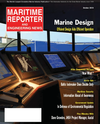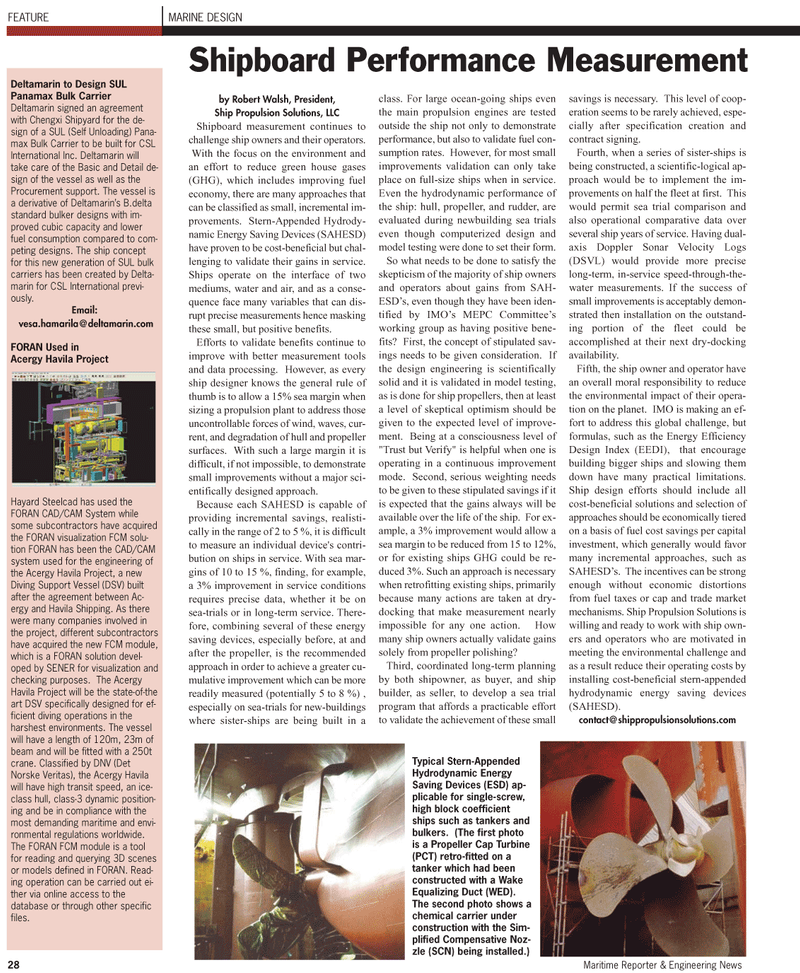
Page 28: of Maritime Reporter Magazine (October 2010)
Marine Design Annual
Read this page in Pdf, Flash or Html5 edition of October 2010 Maritime Reporter Magazine
by Robert Walsh, President,
Ship Propulsion Solutions, LLC
Shipboard measurement continues to challenge ship owners and their operators.
With the focus on the environment and an effort to reduce green house gases (GHG), which includes improving fuel economy, there are many approaches that can be classified as small, incremental im- provements. Stern-Appended Hydrody- namic Energy Saving Devices (SAHESD) have proven to be cost-beneficial but chal- lenging to validate their gains in service.
Ships operate on the interface of two mediums, water and air, and as a conse- quence face many variables that can dis- rupt precise measurements hence masking these small, but positive benefits.
Efforts to validate benefits continue to improve with better measurement tools and data processing. However, as every ship designer knows the general rule of thumb is to allow a 15% sea margin when sizing a propulsion plant to address those uncontrollable forces of wind, waves, cur- rent, and degradation of hull and propeller surfaces. With such a large margin it is difficult, if not impossible, to demonstrate small improvements without a major sci- entifically designed approach.
Because each SAHESD is capable of providing incremental savings, realisti- cally in the range of 2 to 5 %, it is difficult to measure an individual device's contri- bution on ships in service. With sea mar- gins of 10 to 15 %, finding, for example, a 3% improvement in service conditions requires precise data, whether it be on sea-trials or in long-term service. There- fore, combining several of these energy saving devices, especially before, at and after the propeller, is the recommended approach in order to achieve a greater cu- mulative improvement which can be more readily measured (potentially 5 to 8 %) , especially on sea-trials for new-buildings where sister-ships are being built in a class. For large ocean-going ships even the main propulsion engines are tested outside the ship not only to demonstrate performance, but also to validate fuel con- sumption rates. However, for most small improvements validation can only take place on full-size ships when in service.
Even the hydrodynamic performance of the ship: hull, propeller, and rudder, are evaluated during newbuilding sea trials even though computerized design and model testing were done to set their form.
So what needs to be done to satisfy the skepticism of the majority of ship owners and operators about gains from SAH-
ESD’s, even though they have been iden- tified by IMO’s MEPC Committee’s working group as having positive bene- fits? First, the concept of stipulated sav- ings needs to be given consideration. If the design engineering is scientifically solid and it is validated in model testing, as is done for ship propellers, then at least a level of skeptical optimism should be given to the expected level of improve- ment. Being at a consciousness level of "Trust but Verify" is helpful when one is operating in a continuous improvement mode. Second, serious weighting needs to be given to these stipulated savings if it is expected that the gains always will be available over the life of the ship. For ex- ample, a 3% improvement would allow a sea margin to be reduced from 15 to 12%, or for existing ships GHG could be re- duced 3%. Such an approach is necessary when retrofitting existing ships, primarily because many actions are taken at dry- docking that make measurement nearly impossible for any one action. How many ship owners actually validate gains solely from propeller polishing?
Third, coordinated long-term planning by both shipowner, as buyer, and ship builder, as seller, to develop a sea trial program that affords a practicable effort to validate the achievement of these small savings is necessary. This level of coop- eration seems to be rarely achieved, espe- cially after specification creation and contract signing.
Fourth, when a series of sister-ships is being constructed, a scientific-logical ap- proach would be to implement the im- provements on half the fleet at first. This would permit sea trial comparison and also operational comparative data over several ship years of service. Having dual- axis Doppler Sonar Velocity Logs (DSVL) would provide more precise long-term, in-service speed-through-the- water measurements. If the success of small improvements is acceptably demon- strated then installation on the outstand- ing portion of the fleet could be accomplished at their next dry-docking availability.
Fifth, the ship owner and operator have an overall moral responsibility to reduce the environmental impact of their opera- tion on the planet. IMO is making an ef- fort to address this global challenge, but formulas, such as the Energy Efficiency
Design Index (EEDI), that encourage building bigger ships and slowing them down have many practical limitations.
Ship design efforts should include all cost-beneficial solutions and selection of approaches should be economically tiered on a basis of fuel cost savings per capital investment, which generally would favor many incremental approaches, such as
SAHESD’s. The incentives can be strong enough without economic distortions from fuel taxes or cap and trade market mechanisms. Ship Propulsion Solutions is willing and ready to work with ship own- ers and operators who are motivated in meeting the environmental challenge and as a result reduce their operating costs by installing cost-beneficial stern-appended hydrodynamic energy saving devices (SAHESD). [email protected]
FEATURE MARINE DESIGN
Shipboard Performance Measurement
Typical Stern-Appended
Hydrodynamic Energy
Saving Devices (ESD) ap- plicable for single-screw, high block coefficient ships such as tankers and bulkers. (The first photo is a Propeller Cap Turbine (PCT) retro-fitted on a tanker which had been constructed with a Wake
Equalizing Duct (WED).
The second photo shows a chemical carrier under construction with the Sim- plified Compensative Noz- zle (SCN) being installed.) 28 Maritime Reporter & Engineering News
Deltamarin to Design SUL
Panamax Bulk Carrier
Deltamarin signed an agreement with Chengxi Shipyard for the de- sign of a SUL (Self Unloading) Pana- max Bulk Carrier to be built for CSL
International Inc. Deltamarin will take care of the Basic and Detail de- sign of the vessel as well as the
Procurement support. The vessel is a derivative of Deltamarin’s B.delta standard bulker designs with im- proved cubic capacity and lower fuel consumption compared to com- peting designs. The ship concept for this new generation of SUL bulk carriers has been created by Delta- marin for CSL International previ- ously.
Email: [email protected]
FORAN Used in
Acergy Havila Project
Hayard Steelcad has used the
FORAN CAD/CAM System while some subcontractors have acquired the FORAN visualization FCM solu- tion FORAN has been the CAD/CAM system used for the engineering of the Acergy Havila Project, a new
Diving Support Vessel (DSV) built after the agreement between Ac- ergy and Havila Shipping. As there were many companies involved in the project, different subcontractors have acquired the new FCM module, which is a FORAN solution devel- oped by SENER for visualization and checking purposes. The Acergy
Havila Project will be the state-of-the art DSV specifically designed for ef- ficient diving operations in the harshest environments. The vessel will have a length of 120m, 23m of beam and will be fitted with a 250t crane. Classified by DNV (Det
Norske Veritas), the Acergy Havila will have high transit speed, an ice- class hull, class-3 dynamic position- ing and be in compliance with the most demanding maritime and envi- ronmental regulations worldwide.
The FORAN FCM module is a tool for reading and querying 3D scenes or models defined in FORAN. Read- ing operation can be carried out ei- ther via online access to the database or through other specific files.

 27
27

 29
29
